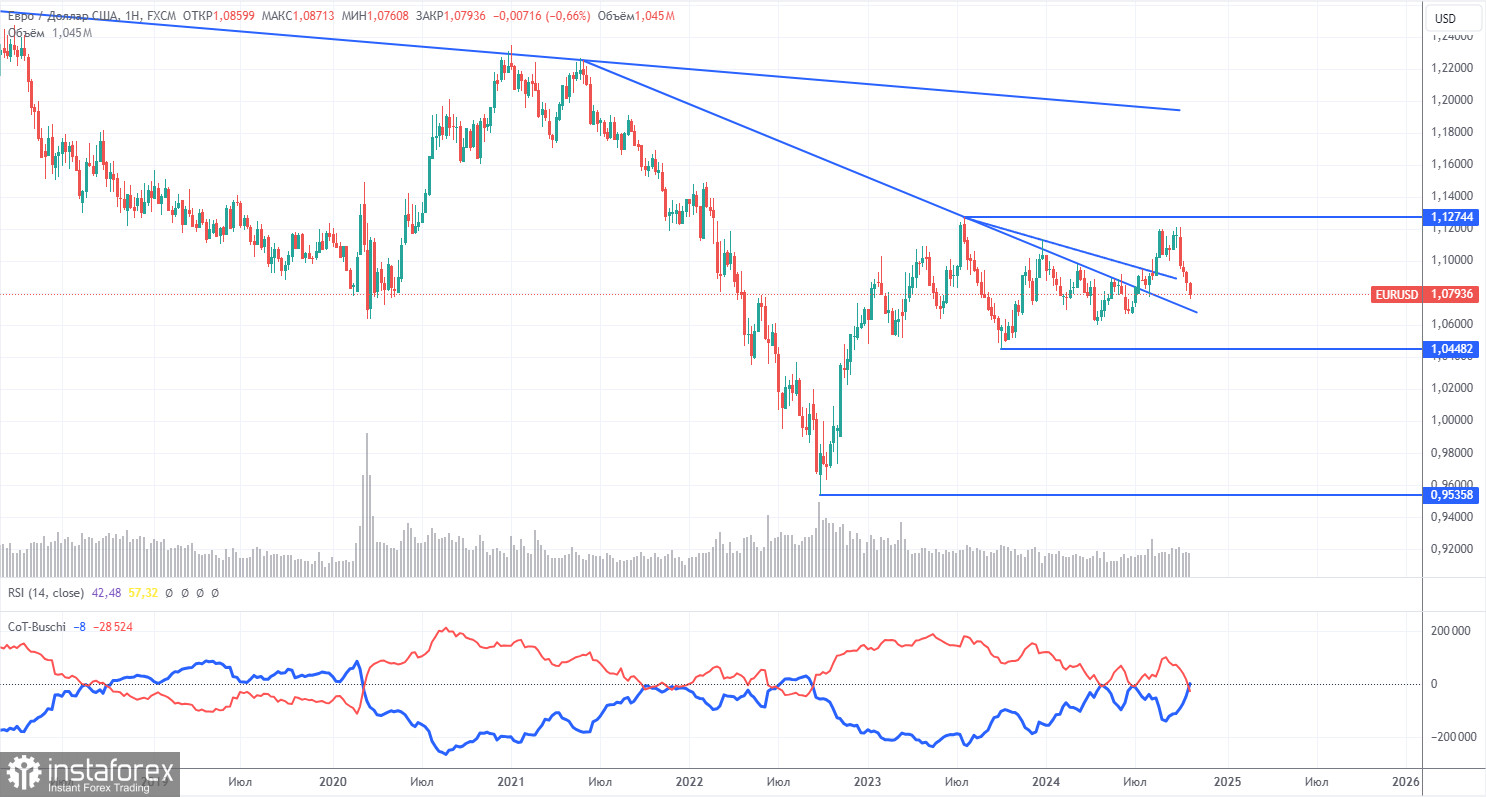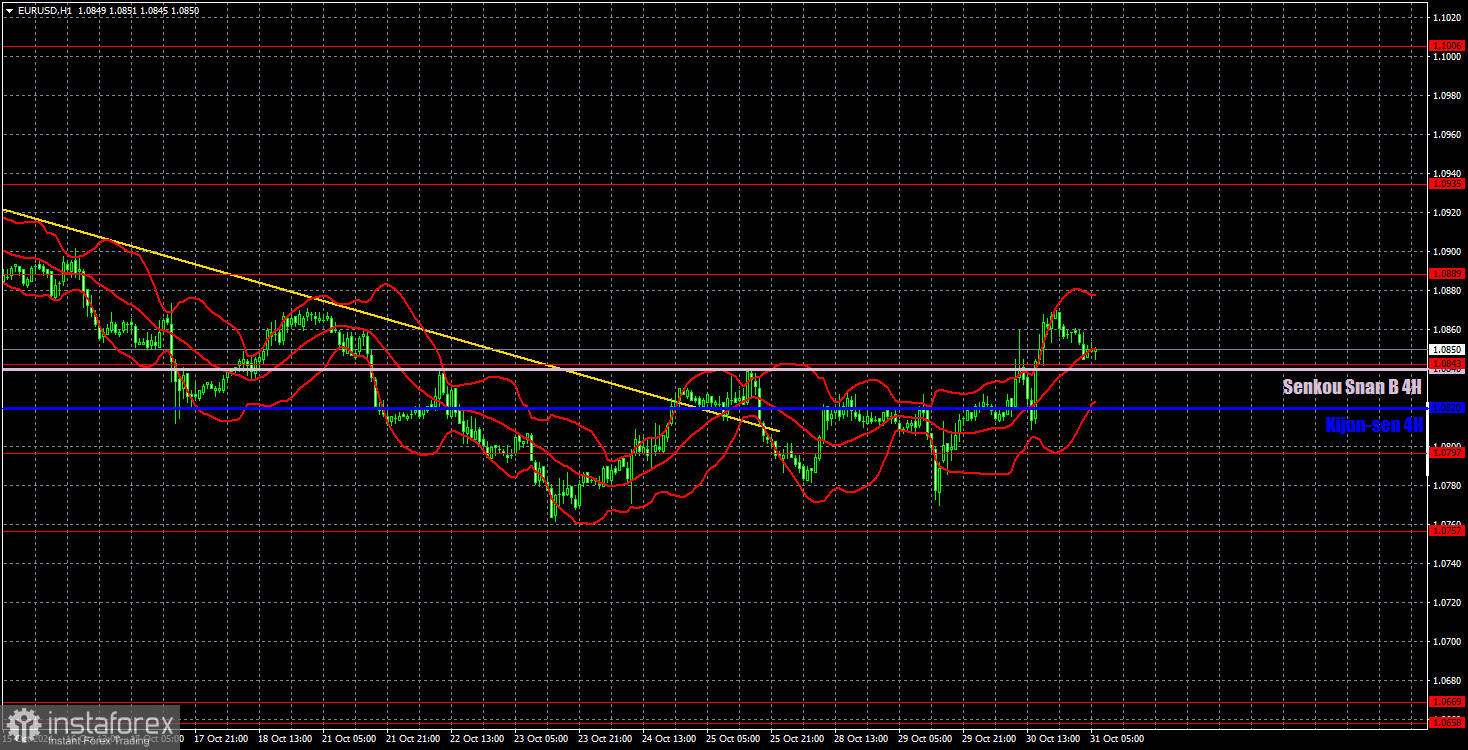EUR/USD 5-Minute Analysis

The EUR/USD currency pair attempted another upward correction on Wednesday. The euro gained 50-60 pips throughout the day, but the macroeconomic background, which significantly impacted trader sentiment yesterday, was quite contradictory. For example, Germany's inflation accelerated to 2%, much higher than forecast, raising concerns that rates might be held at current levels in December. The U.S. ADP report on private-sector job growth doubled forecasts, which should have triggered a decline in the pair rather than a rise. On the other hand, the EU's Q3 GDP exceeded expectations, while U.S. GDP fell short. In short, the pair could have quickly gone up or down yesterday. Ultimately, we saw some growth, but this critical week is far from over.
Today, the Eurozone's October inflation report will be released, potentially providing insight into what to expect from the European Central Bank's next meeting. If inflation in the Eurozone is accelerating, it may prompt the ECB to delay easing its monetary policy. German inflation rose by 0.4% year-over-year yesterday. The U.S. will also release its PCE index, which many consider the Federal Reserve's "favorite inflation gauge." Although we don't entirely agree with this view, it may still trigger a market reaction.
Yesterday, the price fluctuated within a range containing two levels and two lines. Every time a signal formed, the price quickly reached a nearby level or line, making it challenging to trade based on technical signals. The contradictory macroeconomic background didn't help either. We can't say with certainty that the euro's upward correction will continue. The pair could easily fall back to its local lows today or tomorrow.
COT Report Analysis

The latest COT report, dated October 22, shows that the net position of non-commercial traders has remained bullish for a long time, and the bears' recent attempt to gain dominance failed. However, last week saw a sharp increase in the number of short positions opened by professional traders, and the net position became negative for the first time in a while, indicating that the euro is now sold more frequently than bought.
We still see no fundamental reasons for euro strength, and technical analysis suggests that the price is in a consolidation zone – essentially flat. The weekly time frame shows that since December 2022, the pair has been trading between levels 1.0448 and 1.1274, extending from a seven-month flat phase into an 18-month phase. Thus, a further decline remains more likely.
The red and blue lines have crossed and reversed their relative positions. During the last report week, the number of longs in the non-commercial group decreased by 16,200, while shorts increased by 29,500, causing the net position to drop by 45,700. The euro still has strong downward potential.
EUR/USD 1-Hour Analysis

The pair continues its downward movement on the hourly time frame, potentially starting a new prolonged downtrend. There's no need to mention fundamental or macroeconomic reasons for another dollar decline – they don't exist. In the medium term, we expect nothing but a decline in the euro. In the short term, a correction is possible, but the market is not currently eager to buy euros, and the macroeconomic context doesn't firmly support the euro.
For October 31, we identify the following trading levels: 1.0658-1.0669, 1.0757, 1.0797, 1.0843, 1.0889, 1.0935, 1.1006, 1.1092, 1.1147, as well as the Senkou Span B (1.0840) and Kijun-sen (1.0820) lines. The Ichimoku indicator lines may shift throughout the day, so consider this when identifying trading signals. Remember to place a Stop Loss order at break even if the price moves 15 pips in the intended direction to protect against potential losses from false signals.
On Thursday, the Eurozone will publish its key report on inflation, while the U.S. will release the PCE price index, which is also considered significant. Therefore, increased volatility may be expected today.
Chart Explanations:
Support and resistance levels: thick red lines around which movement may end. They are not sources of trading signals.
Kijun-sen and Senkou Span B lines: Ichimoku indicator lines transferred from the 4-hour to the 1-hour timeframe. These are strong lines.
Extreme levels: thin red lines where the price previously rebounded. They are sources of trading signals.
Yellow lines: Trend lines, trend channels, and other technical patterns.
Indicator 1 on COT charts: The net position size for each category of traders.
 English
English 
 Русский
Русский Bahasa Indonesia
Bahasa Indonesia Bahasa Malay
Bahasa Malay ไทย
ไทย Español
Español Deutsch
Deutsch Български
Български Français
Français Tiếng Việt
Tiếng Việt 中文
中文 বাংলা
বাংলা हिन्दी
हिन्दी Čeština
Čeština Українська
Українська Română
Română

